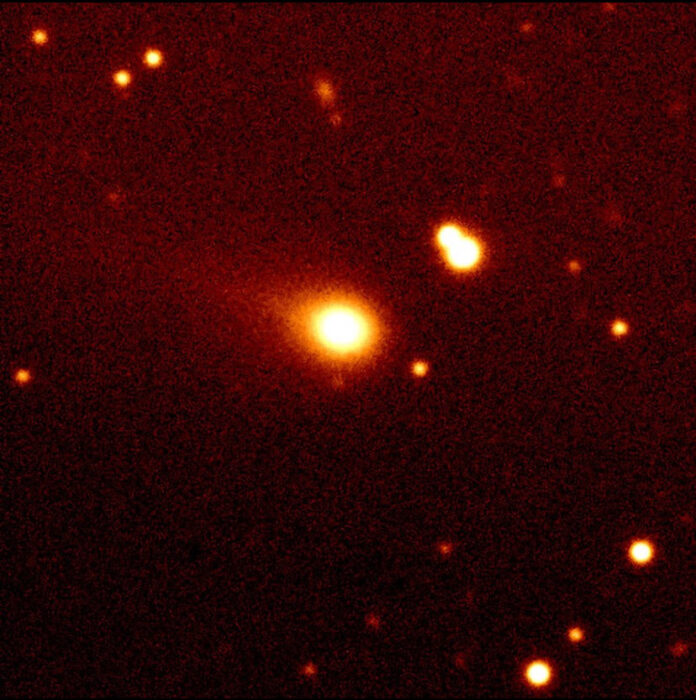By Samuel A. Lopez, USA Herald – October 24, 2025
Something strange is happening behind the Sun.
The interstellar comet 3I/ATLAS, which streaked into our solar system from the depths of interstellar space in July, is now hidden behind the Sun’s blinding glare—beyond the reach of even our most powerful ground-based telescopes.
It’s the same part of the sky where, just weeks ago, astronomers discovered “twilight” asteroid 2025 SC79 – a skyscraper-sized asteroid before it, too, slipped out of view – Hidden by the sun’s glare. Now, as the Sun undergoes one of its most volatile and magnetically active phases in years, a growing number of astronomers are wondering whether these celestial alignments are purely coincidence—or if something deeper is unfolding.
For those who recall ʻOumuamua, the first known interstellar object ever detected, the mystery feels hauntingly familiar. ʻOumuamua behaved like nothing else ever observed. It entered our solar system at a high speed, slowed down inexplicably, and then—after rounding the Sun—sped up again as it departed. No rocket jets, no cometary tail, no visible gas or dust could explain it. Scientists debated for years whether it was a natural shard of alien rock, an icy fragment venting invisible gases, or even a derelict fragment of alien technology.
Now, as 3I/ATLAS has disappeared behind the Sun, some are wondering: Could history be about to repeat itself?
When the comet last appeared in view, it was exhibiting extraordinary behavior. Spectroscopic readings from NASA’s James Webb Space Telescope revealed an unusually high concentration of carbon dioxide and an unexpected level of activity on its surface—traits that already set it apart from every known comet. But that was before it vanished behind the solar curtain. Since then, the Sun itself has grown restless.
Over the past month, solar observatories have recorded a surge in flares, coronal mass ejections, and even geomagnetic storms strong enough to trigger auroras at mid-latitudes. The Sun is nearing its solar maximum, but the recent intensity has caught some experts off guard. And while most scientists caution that linking the Sun’s outbursts to a single celestial body would be speculative, a few voices in the scientific community are beginning to wonder aloud whether there might be a correlation worth exploring.
“If interstellar objects carry magnetic or charged materials unlike our local solar debris, their passage through the Sun’s heliosphere could, in theory, interact with the solar magnetic field,” said one astrophysicist familiar with the ongoing observations. “That doesn’t mean 3I/ATLAS is causing flares—but it might be influencing how plasma flows near the Sun’s outer atmosphere.”
It’s an audacious idea—yet not an impossible one. Both ʻOumuamua and 2I/Borisov showed anomalous acceleration after their close approaches to the Sun. If 3I/ATLAS follows a similar pattern, its post-perihelion speed could reveal whether something unknown is influencing its trajectory. In ʻOumuamua’s case, the increase in velocity couldn’t be explained by standard gravitational mechanics. NASA scientists at the time described the acceleration as “non-gravitational but comet-like,” even though no jets or emissions were visible.
3I/ATLAS is current positioned about 1.4 astronomical units from the Sun, which places it inside a region of space where solar winds can fluctuate wildly. When it emerges on the other side, astronomers will be watching closely to see whether it has fragmented, brightened, or deviated from its projected orbit.
In the meantime, the situation is eerily reminiscent of the newly discovered “twilight” asteroid 2025 SC79, which was found lurking in the Sun’s glare in September of this year. It too moved behind the Sun almost in tandem with 3I/ATLAS. The fact that two unusual celestial objects—one interstellar, one domestic—are both concealed within the same solar zone while the Sun undergoes heightened turbulence has sparked both curiosity and caution.
Could these alignments be a simple product of celestial mechanics, or are we witnessing a deeper cosmic interplay? Some astrophysicists suggest that large interstellar objects may temporarily distort local solar wind patterns as they move through. Others have floated the idea that electromagnetic coupling between the Sun’s plasma and ionized materials from an interstellar comet might briefly alter magnetic flux. Those possibilities remain unproven, but they underscore one reality: we’re still learning how dynamic—and interconnected—our solar environment truly is.
When ʻOumuamua re-emerged from its solar pass, its velocity jump baffled the scientific world. It was gone too quickly for follow-up observations, leaving behind only theories. But this time, the world is watching with better tools. With the Vera C. Rubin Observatory preparing for its first all-sky scans, and multiple planetary missions—including ESA’s Solar Orbiter—tracking activity from multiple vantage points, humanity is far better equipped to study what happens when an interstellar traveler tangles with our star.
If 3I/ATLAS slows down unexpectedly—or speeds up again as it exits the inner solar system—it may confirm that some forces at work in interstellar space still defy our full understanding. And if the Sun’s current unrest continues to intensify during its hidden months, the timing will raise still more questions about whether proximity and plasma are more deeply linked than we thought.
For now, the mystery hides behind a veil of solar light. The world will not see 3I/ATLAS again until late October, when it reappears from the Sun’s far side and enters a portion of sky once more visible from Earth. When it does, astronomers will compare its brightness, tail structure, and velocity to its pre-perihelion state—and the results may either confirm that 3I/ATLAS is just another volatile visitor… or something far more remarkable.
Behind the Sun’s glare, secrets are building. The last time we saw such strangeness, it changed astronomy forever. This time, we’re ready for whatever 3I/ATLAS decides to reveal when it comes back into view.
© 2025 USA Herald
Samuel A. Lopez is an investigative journalist and legal analyst covering space science, technology, and policy for the USA Herald. Follow his work at USAHerald.comand @xSAMUELADAM.



